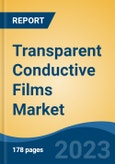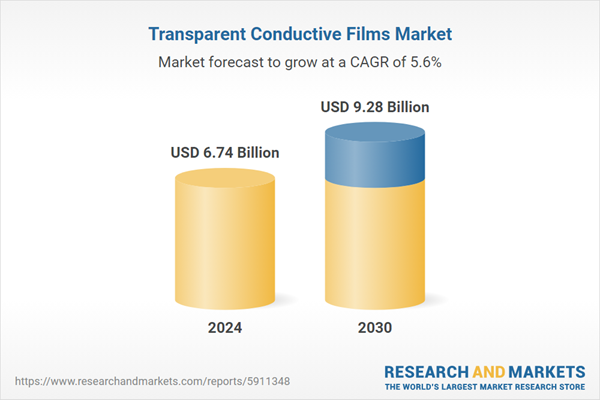Speak directly to the analyst to clarify any post sales queries you may have.
10% Free customizationThis report comes with 10% free customization, enabling you to add data that meets your specific business needs.
Common materials used in TCFs include metal oxides like indium tin oxide (ITO) and fluorine-doped tin oxide (SnO₂\F), metal meshes made of silver, copper, or gold, as well as silver nanowires, graphene, conductive polymers (e.g., PEDOT\PSS), and carbon nanotubes. These materials are selected for their ability to maintain electrical conductivity while remaining optically transparent. The fundamental property enabling transparency is a material's large bandgap, which allows visible light to pass through without absorption. For advanced applications like solar cells, the need for transparency often extends beyond the visible spectrum to maximize energy absorption from the entire solar range.
Key Market Drivers
Increasing Use of Transparent Conductive Films in Biomedical Devices
Transparent conductive films (TCFs) are thin sheets with high electrical conductivity and transparency. They are typically fabricated using materials like indium tin oxide (ITO), graphene, or silver nanowires, which enable their exceptional properties. Due to their unique characteristics, TCFs have found widespread applications in various fields, including electronics, solar cells, and more recently, biomedical devices. By 2030, one in six people globally will be aged 60 or older, and by 2050, 80% of the elderly population will reside in low- and middle-income countries. This demographic shift highlights the growing demand for advanced healthcare technologies and user-friendly electronic devices. Transparent Conductive Films (TCF) are essential in developing medical sensors, wearable health monitors, and easy-to-use touch-enabled devices, making them crucial in supporting healthy ageing and improving the quality of life for the ageing global population.In the biomedical field, the utilization of TCFs is gaining significant traction. These films are seamlessly integrated into biomedical devices such as diagnostic sensors, biosensors, and wearable health monitoring devices, revolutionizing the healthcare landscape. TCFs offer several advantages in these applications. Their excellent sensitivity and selectivity make them ideal for detecting and monitoring various health parameters, enabling personalized and precise healthcare. Furthermore, the transparency of TCFs allows for real-time visual inspection, facilitating accurate diagnostics and monitoring.
The rising adoption of TCFs in biomedical devices is a significant driving force behind the growth of the global TCF market. As the biomedical industry continues to innovate and develop more sophisticated devices, the demand for TCFs is expected to surge further. The ongoing COVID-19 pandemic has underscored the critical importance of remote health monitoring and diagnostics, leading to an increased demand for devices like biosensors and wearables. This, in turn, has fueled the need for TCFs, as they play a vital role in enabling advanced healthcare technologies.
Thus, the increasing use of transparent conductive films in biomedical devices is a key driver of the global TCF market. As the biomedical field continues to advance and the demand for sophisticated diagnostic and monitoring devices grows, the adoption of TCFs is likely to rise further, propelling the growth of the global market and revolutionizing the way healthcare is delivered and monitored.
Key Market Challenges
Limited Supply of Indium
Indium, with its remarkable electrical conductivity and transparency, plays a critical role in the production of transparent conductive films (TCFs). The most widely used material in TCFs is indium tin oxide (ITO), a compound that exhibits superior optical and electronic properties, making it the preferred choice for a wide range of applications.However, despite its significance, the availability of indium is becoming a growing concern. Indium reserves are limited, and the combination of increasing demand and limited supply raises concerns about the long-term sustainability of indium supply. Moreover, the high price of indium further compounds this issue, imposing restrictions on market growth and compelling manufacturers to explore alternative options.
The limited supply of indium presents a significant challenge to the TCF market. As the demand for TCF applications like touchscreens and solar panels continues to rise, the need for indium will inevitably increase. However, without an adequate and sustainable supply, the market may face production constraints that could potentially impede its growth. It becomes crucial for industry players to proactively address these challenges and seek out innovative solutions for a sustainable and thriving TCF market.
Key Market Trends
Advancements in Touchscreen Technology
Transparent conductive films (TCFs) play a crucial role in the realm of touchscreen technology, permeating various devices like smartphones, tablets, laptops, and many others. Acting as the active component of capacitive touchscreens, these films facilitate the registration of touch inputs, enabling seamless user interactions. With the proliferation of smart devices and the ever-increasing demand for interactive displays, the utilization of TCFs in touchscreen technology has witnessed a remarkable surge in recent years. This surge can be attributed to the relentless pursuit of an enhanced user experience, improved functionality, and the desire for larger, thinner, and more flexible screens.As the world of touchscreen technology continues to evolve at a rapid pace, the quest for more sophisticated TCFs becomes inevitable. For instance, the rising trend towards flexible and foldable screens necessitates the development of TCFs that can maintain their conductivity and transparency even when subjected to bending. Similarly, the demand for larger screens and advanced multi-touch functionality requires TCFs with superior conductivity and sensitivity. The advancements in touchscreen technology have a profound impact on the global TCF market. As touchscreen devices evolve and become more prevalent, the demand for more advanced TCFs continues to grow, thereby propelling the expansion of the market. The adoption of touchscreen technology in industries beyond consumer electronics, such as automotive and retail, further fuels this demand and opens up new avenues for market growth.
The ongoing advancements in touchscreen technology represent a significant trend in the global transparent conductive films market. As touchscreen devices continue to evolve and find new applications in various industries, the demand for TCFs is expected to rise, driving the growth of the global market.
Key Market Players
- 3M Company
- Nitto Denko Corporation
- Toyobo Corporation
- DuPont Teijin Films U.S. Limited
- Eastman Kodak Company
- Fujifilm Holdings Corporation
- Canatu Oy
- DONTECH Inc.
- Cambrios Technologies Corporation
- TDK Corporation
Report Scope:
In this report, the Global Transparent Conductive Films Market has been segmented into the following categories, in addition to the industry trends which have also been detailed below:Transparent Conductive Films Market, By Material:
- Indium Tin Oxide (ITO) on Glass
- Indium Tin Oxide (ITO) on PET
- Silver Nanowire
- Carbon Nanotubes
- Conductive Polymers
- Others
Transparent Conductive Films Market, By Application:
- Smartphones
- Notebooks
- Tablet
- PC
- Wearable Devices
- Others
Transparent Conductive Films Market, By Region:
- North America
- United States
- Canada
- Mexico
- Europe
- France
- United Kingdom
- Italy
- Germany
- Spain
- Asia-Pacific
- China
- India
- Japan
- Australia
- South Korea
- South America
- Brazil
- Argentina
- Colombia
- Middle East & Africa
- South Africa
- Saudi Arabia
- UAE
- Egypt
Competitive Landscape
Company Profiles: Detailed analysis of the major companies present in the Global Transparent Conductive Films Market.Available Customizations:
With the given market data, the publisher offers customizations according to a company's specific needs. The following customization options are available for the report.Company Information
- Detailed analysis and profiling of additional market players (up to five).
This product will be delivered within 1-3 business days.
Table of Contents
Companies Mentioned
- 3M Company
- Nitto Denko Corporation
- Toyobo Corporation
- DuPont Teijin Films U.S. Limited
- Eastman Kodak Company
- Fujifilm Holdings Corporation
- Canatu Oy
- DONTECH Inc.
- Cambrios Technologies Corporation
- TDK Corporation
Table Information
| Report Attribute | Details |
|---|---|
| No. of Pages | 185 |
| Published | July 2025 |
| Forecast Period | 2024 - 2030 |
| Estimated Market Value ( USD | $ 6.74 Billion |
| Forecasted Market Value ( USD | $ 9.28 Billion |
| Compound Annual Growth Rate | 5.5% |
| Regions Covered | Global |
| No. of Companies Mentioned | 10 |









